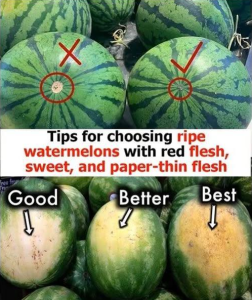Choosing a watermelon that’s perfectly ripe, sweet, and thin-fleshed can feel like a gamble at the market. But with a few simple tips, you can select a watermelon that delights your taste buds and offers that juicy, crisp texture we all love on a hot day. Here are some easy ways to pick the best one every time:
1️⃣ Look for the Field Spot
The field spot is the creamy, yellowish patch on the watermelon where it sat on the ground while ripening. A rich, buttery yellow or orange field spot signals that the melon had time to sweeten on the vine. If the spot is white or pale green, it likely means the watermelon was picked too early and won’t be as sweet.
2️⃣ Check the Skin
A ripe watermelon will have a dull, matte rind rather than a shiny one. A glossy exterior usually means it’s under-ripe. Also, look for consistent dark green stripes (on striped varieties) — they should be bold and distinct. Avoid melons with cuts, dents, or bruises that could signal damage or overripeness.
3️⃣ Give It a Tap
One of the oldest tricks in the book is the sound test. When you thump or tap a ripe watermelon, it should produce a deep, hollow sound — a bit like a drum. If the sound is dull or flat, the watermelon may be overripe or mushy inside. This method takes a little practice, but once you get the hang of it, it’s surprisingly reliable!
4️⃣ Feel the Weight
Pick up the watermelon and compare it to others of similar size. A good one will feel heavy for its size, a sign that it’s packed with water and juice — both indicators of ripeness and sweetness. A lighter melon may be dry or less juicy.
5️⃣ Check the Shape
Uniform shape is key. A round or oval watermelon that’s symmetrical typically grew evenly and got consistent sun and water. Misshapen melons may have experienced irregular growth or stress, which can affect sweetness and texture.
6️⃣ Examine the Webbing or Sugar Spots
That brown, web-like scarring or those little rough patches that look like scratches are actually signs of high sugar content. These marks form where bees pollinated the flower, leading to sweeter fruit. A melon with some webbing is often sweeter than one without.
7️⃣ Thin-Flesh Clues
While the thickness of the rind can vary slightly by variety, a heavy, dull-skinned watermelon with a large, rich field spot is more likely to have a good flesh-to-rind ratio. When sliced, a thin-rind watermelon will show a bright red or pink interior with only a narrow white layer between flesh and outer skin.
